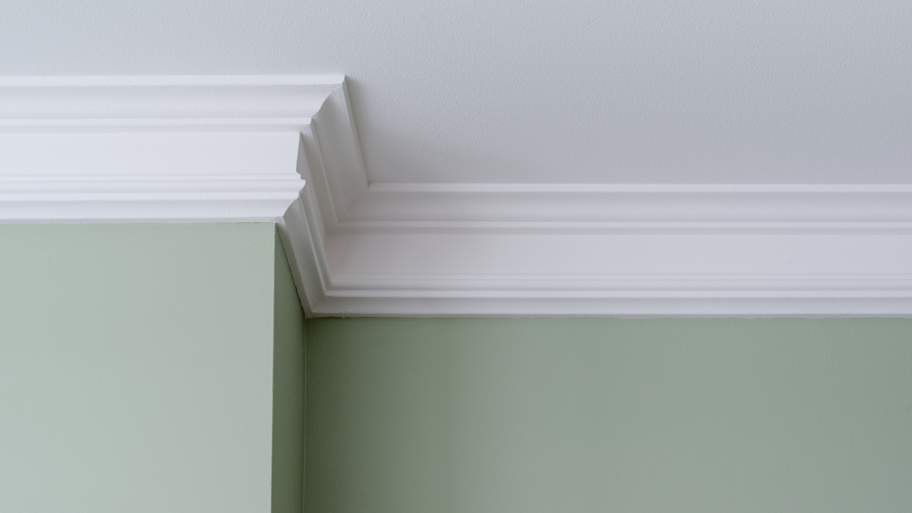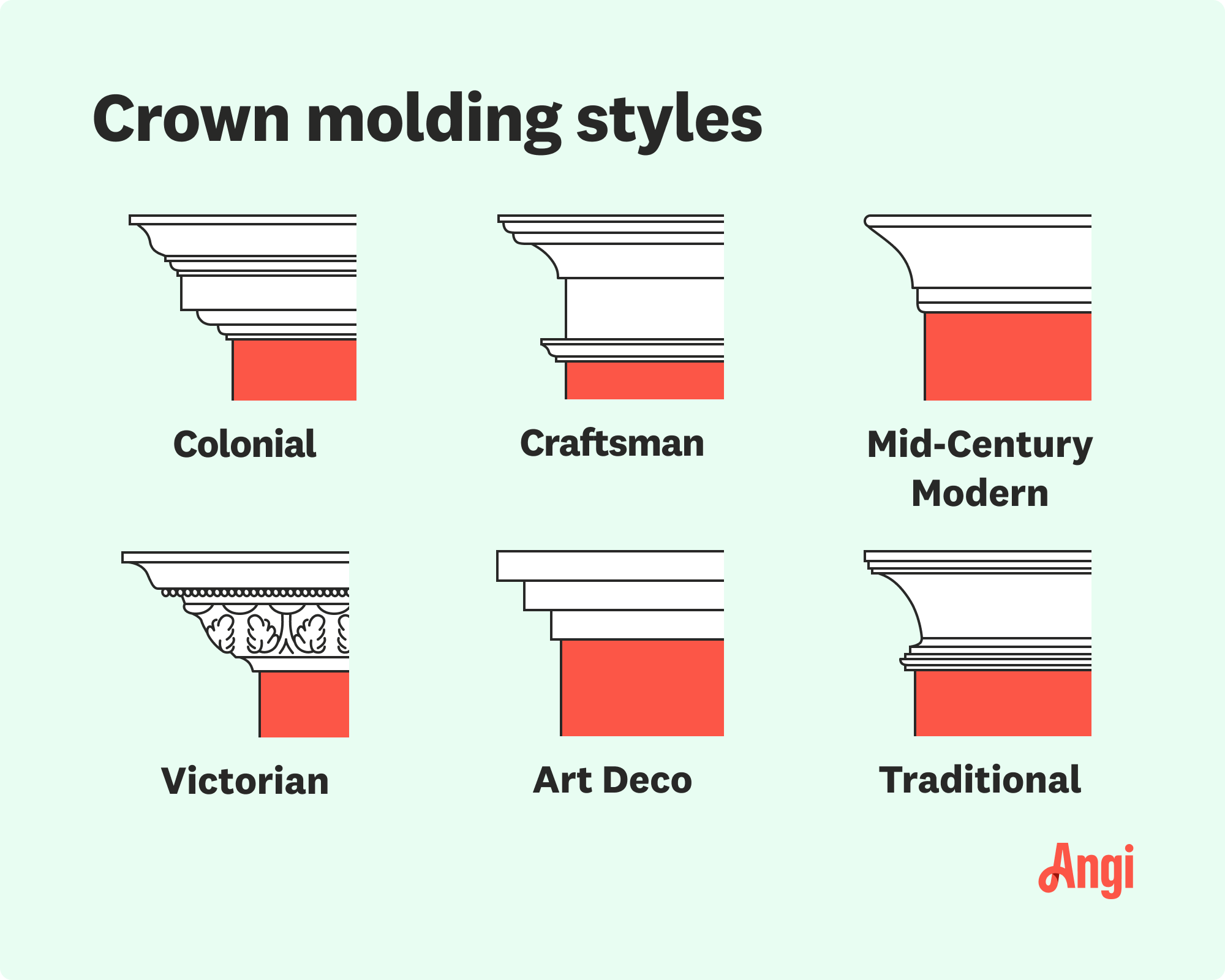
Installing trim can give your home a finished, polished appearance. Learn how much it costs to install trim and what factors affect how much you’ll pay.
Crown molding removal costs $185 on average, with most homeowners spending between $95 and $285 per room. A professional contractor will assess the type of molding, room size, and complexity to determine your total cost.


The type of molding material, installation method, and project complexity significantly affect the removal price.
Crown molding removal costs most homeowners between $1 and $4 per linear foot.
Removing molding from a small bedroom starts at $44, while removing it from a whole house can cost up to $1,600.
Plaster molding is the most expensive to remove, costing $2.50 to $4.50 per linear foot.
Labor rates range from $40 to $80 per hour, depending on your location and the project complexity.
If you’re looking to upgrade your crown molding, you’ll need to remove the old material. Crown molding removal costs $185 on average, per room, or about $1 to $4 per linear foot. However, you could pay as little as $50 or as much as $600 depending on the type of molding, the size of the room, and the complexity of the project as a whole.
The project size is one of the most important factors in crown molding removal costs. Contractors typically charge per linear foot, with larger rooms requiring more time and labor. Most rooms have between 40 and 80 linear feet of crown molding.
| Room Size | Approximate Linear Feet | Estimated Removal Cost Range |
|---|---|---|
| Small bedroom (10x12) | 44 feet | $44–$176 |
| Medium living room (14x16) | 60 feet | $60–$240 |
| Large family room (16x20) | 72 feet | $72–$288 |
| Great room (20x24) | 88 feet | $88–$352 |
| Whole house average | 200–400 feet | $200–$1,600 |

The type of crown molding has a significant impact on removal costs. Different materials require different techniques and time investments to remove safely without damaging walls or ceilings.
| Molding Material | Estimated Removal Cost per Linear Foot | Difficulty Level | Typical Removal Time (Minutes per Foot) |
|---|---|---|---|
| MDF/Composite | $1–$2 | Easy | 2–4 |
| Pine/Softwood | $1.25–$2.50 | Easy to moderate | 3–5 |
| Hardwood | $1.50–$3.00 | Moderate | 4–6 |
| Plaster/Built-up | $2.50–$4.50 | Difficult | 8–15 |
| Polyurethane | $0.75–$1.75 | Easy | 2–3 |
The location of crown molding in your home can impact removal costs, as some locations are more difficult to reach and work in than others.
| Location | Cost Impact | Considerations |
|---|---|---|
| Ground floor rooms | Standard rates | Easy access, standard ceiling height |
| Second floor/upstairs | +10%–15% | May require additional equipment |
| Vaulted/cathedral ceilings | +25%–40% | Requires specialized ladders or scaffolding |
| Stairwells | +30%–50% | Complex angles, difficult access |
| Bathrooms/kitchens | +15%–25% | Potential moisture damage, tight spaces |
Several factors beyond the basic removal can impact your total project cost.
Professional crown molding removal costs between $40 and $80 per hour in labor fees. The project typically takes one to three hours for an average room, depending on the type of molding and its complexity.
Professional contractors who specialize in trim work may charge premium rates, but often complete the job more efficiently. When hiring a pro, expect to pay for a minimum service call of two to three hours, even for smaller jobs.
Crown molding removal typically doesn't require permits since it's considered cosmetic work that doesn't affect structural elements. However, if your removal is part of a larger renovation project, you may need permits for related work.
Removing crown molding often reveals imperfections or damage that needs repair before painting or installing new molding. Common drywall repair costs include:
Minor damage (DIY with compound and paint): $10–$55 per room
Small holes: $20–$120
Crack repair: $60–$400 professionally, depending on severity
Drywall ceiling repair: $220–$1,300, depending on the extent of damage
Water damage repair: $600–$1,550 per affected area
Most contractors include basic cleanup in their quotes, but disposal of materials may cost extra depending on the project scope and local regulations. Typical post-project cleaning costs to plan for include:
Small-scale debris disposal: $100–$300
Construction waste removal (by truckload): $100–$800
Hazardous material disposal (if lead paint is present): $150–$300
Common additional services you might need during crown molding removal include:
Paint touch-up work: $50–$300 per project (based on room size and scope)
Adhesive removal: Professional cleaning rates of $20–$50 per hour
Electrical work (if molding conceals wiring): $50–$100 per hour
Wallpaper removal in affected areas: $3 per square foot
Compared to the cost of removal alone, the cost to install crown molding averages $1,200. But beyond cost, consider the condition and style of your existing molding alongside your renovation goals.
| Factor | Remove Only | Remove and Replace |
|---|---|---|
| Estimated cost | $95–$285 | $610–$2,120 |
| Timeline | 1–2 days | 3–5 days |
| Home value impact | Neutral to negative | Potentially positive |
| Style update | Achieves modern look | Allows style customization |
| Complexity | Low to moderate | Moderate to high |

Crown molding removal alone doesn't typically add monetary value to your home, but it can contribute to a fresh, modern aesthetic that appeals to certain buyers. The value depends on your specific situation:
Positive Value Scenarios:
Removing outdated or damaged molding before selling
Creating clean lines for contemporary design
Part of a comprehensive room update
Neutral to Negative Scenarios:
Removing quality hardwood molding in traditional homes
Creating an unfinished appearance without follow-up improvements
Reducing architectural character in period homes
The key is to ensure that removal aligns with your overall design goals and target market preferences.
With some clever bundling and a little DIY power, you can cut your overall costs.
Bundle with other projects: Combine removal with painting or other trim work for a more efficient process.
Handle your own prep work: Move furniture and protect floors yourself.
Keep salvageable pieces: If you plan to reinstall elsewhere, you’ll have fewer materials to buy and prep.
Get multiple quotes: Prices can vary significantly between contractors.
Consider a partial DIY approach: For example, remove the molding yourself and hire pros only for wall repair.
DIY crown molding removal costs $25 to $75 in tools and supplies (such as a utility knife and pry bar), potentially saving $125 to $225 in labor costs. Keep in mind that when you DIY, you run the risk of wall damage, ceiling cracks, being unable to entirely remove tricky sections, and ladder mishaps.
For complex molding installations, plaster walls, vaulted ceilings, or when preserving the wall is critical, consider hiring a crown molding professional near you.
DIY crown molding removal can lead to costly and inconvenient mistakes. Here’s why it’s best to hire a seasoned pro:
Pros have the tools and expertise to quickly and safely remove molding from your home.
They understand how to avoid common mistakes that can damage drywall, plaster, and paint.
Experienced pros can safely remove molding near electrical outlets, light fixtures, and crown transitions.
Improper DIY removal can lead to cracked walls, broken molding, and uneven surfaces.
Professional removal ensures the integrity of your walls, making refinishing or installing new molding easier.
If you want to assist with the molding removal process, consider the following tasks:
Remove rugs, furniture, and decor from the area before removal.
Put drop cloths or protective coverings over the floors or surrounding furniture.
Keep tools and equipment nearby and readily accessible for your pro.
Paint or stain the walls and ceilings yourself after removing the molding.
Know which rooms you want the crown molding removed from and the general measurements of the project.
Have a general idea of the molding style and type, such as wood, MDF, or polyurethane.
Notify your pro of any specific challenges, like high ceilings or light fixtures.
If there is room left in your budget, ask your pro about new molding installation or refinishing options.
Home is the most important place on earth, which is why Angi has helped more than 150 million homeowners transform their houses into homes they adore. To help homeowners with their next project, Angi provides readers with the most accurate cost data and upholds strict editorial standards. We extensively research project costs to develop the pricing data you see, so you can make the best decisions for you and your home. We rely on reputable sources, including the U.S. Bureau of Labor Statistics, academic journals, market studies, and interviews with industry experts—all to ensure our prices reflect real-world projects.
Want to help us improve our cost data? Send us a recent project quote to [email protected]. Quotes and personal information will not be shared publicly.
From average costs to expert advice, get all the answers you need to get your job done.

Installing trim can give your home a finished, polished appearance. Learn how much it costs to install trim and what factors affect how much you’ll pay.

When calculating the cost of building a treehouse, consider the size, types of materials, and design. This guide will help you figure out what to budget.

Discover the cost to install a stair railing, including average prices, key cost factors, and tips to save on your project.

While there is a standard staircase size, you have a lot of leeway to size for comfort or space constraints. Learn about average sizes and minimums.

When you want maximum durability, consider selecting between PVC crown molding versus wood. PVC is moisture resistant, while wood gives you a vintage design.

Learn how to replace a broken or damaged railing spindle in just a few steps with basic tools. See how to measure, remove, and install a new spindle safely.